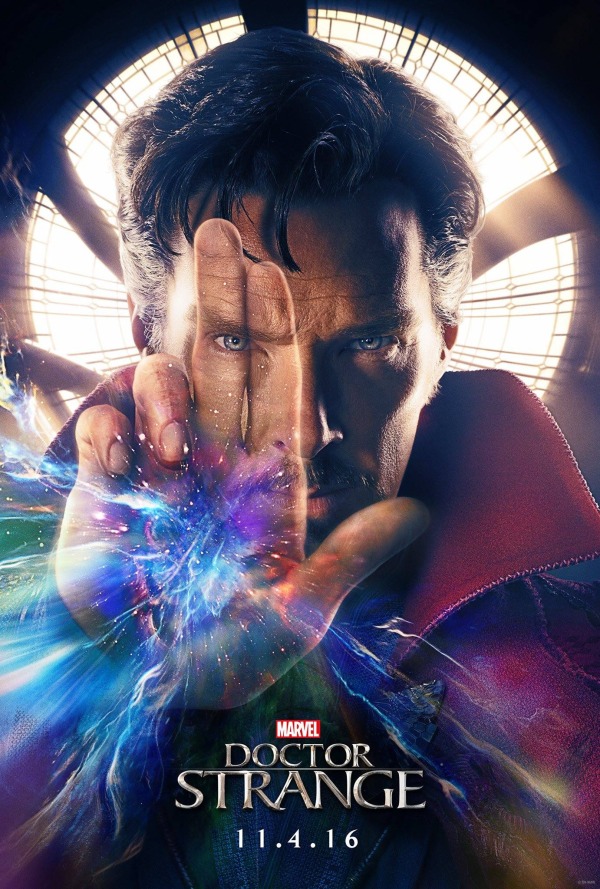DOCTOR STRANGE (2016, directed by Scott Derrickson, 115 minutes, USA)
BY RICHARD SUPLEE By now everyone knows what to expect from a superhero film. We get one every other month and they all follow the same pattern: A man suffers some tragedy, acquires impossible abilities, finds an enemy with similar abilities he has to fight to protect the world, and he saves the world. A love interest and (at least in the case of the Marvel Cinematic Universe) tons of sarcasm are usually sprinkled throughout. There are some minor variations (the man might be a god or a whole team or the tragedy might be WWII) but superhero films tend to stick to the formula. Doctor Strange is no different. But following a formula is not a bad thing. Doctor Strange is like a well crafted pantoum or sonnet. The constraints of the genre allows the film to both meet and subvert expectations.
Dr. Stephen Strange (Benedict Cumberbatch) is a neurosurgeon who saves lives. He is also a prick. He rubs it in another surgeon’s face as he saves the life of a patient mistakenly declared dead and refuses patients that can’t realistically be saved so he can keep his perfect record. But before the audience wants to punch Strange in the face too much, he gets into a terrible car accident that cripples his hands. Once it is confirmed that even experimental western medicine cannot fix him, he ends up in Kathmandu, Nepal. This is where the magic comes into the movie. Strange is a man of science so naturally he is skeptical but he soon learns magic is real when The Ancient One (Tilda Swinton) throws him through a couple dimensions. And this is actual magic. It isn’t Thor’s “magic is just advanced science and gods are just aliens” version of magic. The Ancient One straight up calls them spells.
Over the course of the film’s 115 minutes, Strange slowly gathers familiar Mcguffins from the comics (such as the Cape of Levitation, which is self-explanatory, and Eye of Agamotto, which is a forbidden object that can rewind time). The film then cuts to Doctor Strange getting a crash course in magic from The Ancient One and Karl Mordo (Chiwetel Ejiofor), loyal follower of The Ancient One, and master sorcerer Wong (Ben Wong). Sidenote, thank god writer/director Scott Derrickson updated Wong from the racist Asian manservant stereotype he was in 1963. The film’s villain, Kaecilius (Mads Mikkelsen) a former student of The Ancient One who has gone over to the dark side. Surprise, he seeks forbidden power from The Dark Dimension, a cancerous dimension controlled by the demonic entity Dormammu.
Most 3D films (especially superhero ones) don’t really need 3D. But the film’s reality-defying phenomenon — walking through other dimensions, folding reality, and the obligatory ghosts fights — are served well by it. Doctor Strange has always been psychedelic comic and needed strange visuals to work. All that tripping across different dimensions triggers Inception-like visuals. The action climaxes with Dormammu in the form of a giant nebula in The Dark Dimension. Usually when a powerful villain is turned into a giant space cloud the movie suffers. But Dormammu’s demonic body was always a generic and uninspiring visual in the comics. Also, the climax isn’t the predictable scenario of Doctor Strange, Mordo, and Wong going into the Dark Dimension and shooting magic missiles until the unkillable bad guy is killed by the deus ex machina.
Strange confronts Dormammu and uses the Eye of Agamotto to create a time loop he cannot escape from. Dormammu surrenders to Strange’s commands once he realizes he’s beaten. This is by far my favorite fight in a superhero movie (beating out even The Avengers finale that saw everyone kicking alien ass). Not only is it unique, it sums up Strange’s personality and development. He’s willing to die forever to save the world. It also sums up the difference between Doctor Strange and Mordo. Despite the victory, Mordo cannot accept using time magic (time is a natural process and magic should never alter it).
Once Dormammu is defeated, the film ends fairly quickly. And despite the familiar feel of this movie, it succeeds. The character development of Strange from a man who refuses to try the impossible for fear of failure into a man who wields impossible magic and is willing to fight an unbeatable foe is so believable from Cumberbatch. People who don’t read the comics and have no idea what a Sorcerer Supreme or Living Tribunal is don’t need to worry. Strange’s own ignorance of this world means someone explains it to him. The predictable structure also helps ease you into the world. Chiwetel Ejiofor’s Karl Mordo is destined to become Marvel’s next great villain. The fact that the film didn’t use Mordo as the main villain allows the audience to care about him when he does become a villain in the sequel. The visuals and performances are enough for the movie to be in my top five superhero films of all time.

